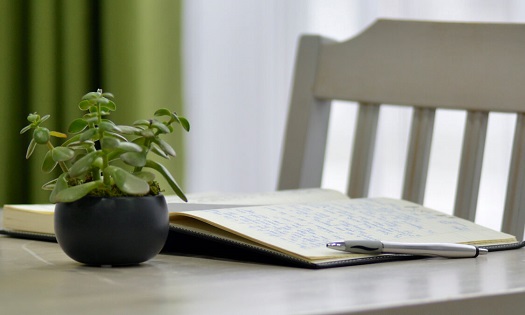How to Practice Writing Meditation: For Beginners and Non-Beginners
Writing can be used as a form of meditation and can be a wonderful source of insight. This method helps to reduce stress, quiet your mind, and focus your attention.
This article includes a short guided writing meditation and worksheet for you to try.

Learn about the key concepts for sustaining a fruitful meditation practice here (includes a guided breath meditation for beginners and advanced practitioners).
Writing meditation is not the same as journaling. You do not need to write about events, your life, opinions or “come up” with a topic to write about.
Nor do you need to produce any sort of literary work or follow a specific format, and spelling and grammar are optional.
No decisions need to be made and it requires minimal effort.
For myself, I sometimes turn what I write into very simple, short poetry, other times I write what I am experiencing in the moment or thoughts that pop into my head.
In either case, you do not need to have a format or goal in mind. Just see what arises spontaneously in each moment, without any judgment.
Who this practice is for:
Note, there may be other ways to practice writing meditation. This way is very simple.
Anyone can use this method, whether you consider yourself a good writer or not, is irrelevant.
Likewise, it does not matter if you are new to meditation or have been practicing for a long time.
It is another way you can deepen your practice and you may be surprised at what you produce from a place of presence.
Writing meditation can also help those who are looking for ways to manage their mental health with meditation and mindfulness practices.
In addition, if you are someone who works in a creative field this way of meditating can bring newfound inspiration and creativity into your work, especially if you have been feeling stuck for a while.
Benefits of practicing writing meditation:
- Reduce stress
- Cope with anxiety and depression
- Alternative to other forms of meditation when your mind is racing, or if you are having a hard time sitting still, or tend to fall asleep during meditation.
- Improves self-awareness.
- Find solutions to difficult situations.
- Boosts creative thinking. In fact, your writing can turn into poetry or a short story. For example, here is a poem I added today from my own writing meditation.
- Teaches you to let go
- It helps your thinking to become more linear and focuses your attention.
- Redirects your attention to the present moment
- Grounds you

How to Practice Writing Meditation:
If possible, I encourage you to try it right now for about five minutes.
Grab a pen and paper, and find somewhere you won’t be disturbed for the next five minutes.
Remember, you do not need to know what to write. For your convenience, I have also included an audio file for the guided meditation.
Get my free printable Mindful Writing Activity (PDF) to practice with
OR Click here to jump to the audio file (mp3)
OR continue reading below (guided writing meditation script)
Guided Writing Meditation Script:
To begin your writing meditation, simply sit for a few moments with your writing tools in front of you, and take a few deep breaths.
Don’t worry about where your hands or feet should be, and for now, you can keep your eyes open. Relax your body, relax your jaw, and relax the muscles in your face.
Let go of any tension you may be carrying in your back and in your shoulders. For now, forget everything you need to do and think about.
Start by becoming aware of your surroundings.
It does not matter if you are indoors or outdoors.
What do you notice?
Take some time to look around and when you are ready, pick up your pen and write the first thing that comes to mind.
It does not need to make sense and you can simply start by writing one word or even one letter.
As you look around, you may see a chair or a table, you can then write the word “table”.
If you have the thought, “I don’t know what to write,” then you can write that.
If nothing else, you can simply allow the pen to just move across the paper.
Continue breathing deeply and relaxing. You can even write the word “relax”. At this point, just continue writing anything that comes to mind.
If your mind is wandering, just notice whatever thoughts come up and write them down.
Remember there is no format for this method.
If you want to close your eyes, you can take a few more breaths and when you reopen them, just continue writing whatever comes to mind.
It can be a feeling, a thought, something you are seeing; engage all of your sense perceptions.
Perhaps you will notice a smell, a color, maybe even the feeling of your own body.
Don’t worry about writing anything positive or negative, just write.
Maybe a memory comes up or perhaps even some poetry begins to flow.
If at any point your writing takes a direction that you want to follow, feel free to move with that flow.
Just be here, now, in this moment, where nothing matters, and everything is okay.
Do not view what you write with any judgment or criticism.
Allow yourself to relax into your writing meditation and know that anything you write, is okay. Forget about the format, your spelling, and your grammar.
Do not say that a certain word, thought or emotion should not be there.
If your mind comes to a space of silence and stillness, just close your eyes and resume your meditation without writing.
You can maintain your attention on your breathing, your body, or your hands instead.
If you choose to continue meditating without your writing tools, you may notice the same thoughts coming up.
Now that you have already observed them on paper, it will be easier to let these thoughts go and continue with the practice.
You can just sit and observe the thoughts coming and going. Seeing them as unnecessary or repetitive, and letting them go.
If there is something top of mind, you would have already gotten that out on paper, and you can go back to it later.
There is no need to hold onto it. If you cannot let go, then this too is okay. Everything in this moment is perfectly okay.
If you are still writing, or want to resume writing, you may even go into a contemplative state. Perhaps some insights may come up or maybe there is more you want to get off your chest.
Continue now in the way that makes the most sense for you. When you are ready you can end your practice with a few deep breaths.
Audio:
The Guided Writing Meditation Audio Track:
Takeaways: Key Things to Remember
This was a brief meditation but you can extend this practice as much as you want.
Additionally, If any difficult emotions came up and you want to address them further, I have written a post about facing painful emotions.
Likewise, if your mind continued to race, you can also read disentangle from thoughts.
It is important to see how your mind works, the mind likes to wander and think, and this meditation helps you observe the nature of your mind.
The more you are aware of your surroundings and your breathing, the more you can shift your attention away from your mind.
Just be present with your experience, allow what happens to be there, and see how it unfolds without trying to control too much. Eventually, you will feel more at ease and peaceful.
Feel free to come back to this meditation at any time.
May you be happy and well,
Ravelle
Get free resources and updates on meditation, mindfulness, and mental health when you join my email list.
Don’t forget to get your free printable Mindful Writing Activity that you can use anytime!
Related Category:
Related Articles:
Breath Meditation: Sustaining a Fruitful Practice
Break the Shackles of Inner Turmoil: 3 Ways to Free Yourself

